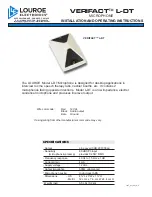
ConneXions II V7 MAC Mains, Multi Port Version
CONV7MAC 05/98
Issue 1
12
Section 3: Technical Information
Next follows the 7 digit pager identity number. All seven digits must be used.
The letter following the identity is the beep type of which there are four valid characters, A, B, C or D.
Next follows the message to be transmitted, which can include:
0-9, space, -(hyphen), ‘U’ (letter U for ‘U’rgent), [,] open/close square brackets, (open square brackets can
also be used to identify the letter ‘C’ for ‘C’ancel). The final character sent is ‘carriage return’ which is not
transmitted but represents the end of message marker.
On sending a message to the unit in the correct format the transcoder will immediately recompose the
string into the POCSAG format and transmit the same at the pre-programmed baud rate. This will be
accompanied by the green LED lighting for the same period to show that data is being transmitted. The
time taken to transmit the message is dependent upon the pager baud rate. For 512 baud this is
approximately 4 seconds, whilst at 1200 baud the time is approximately 2 seconds. The unit can accept
sequential data at 9600 baud which will be buffered and dealt with as soon as the preceding transmission
has ended. The RTS line from the transcoder will only go high in the unlikely event that the message buffer
is full.
Alphanumeric Pagers
Example serial message string:-
A0012300A This is a message <CR>
The data format is exactly as for numeric pagers, except that the recognition character at the front of the
message is changed from an ‘N’ to an ‘A’.
Transmission baud rate: in the above example, the default baud rate is sent.
To change the transmission baud rate in a message string, placing a letter “N” after the “A” will alter it to
512 baud. Placing a letter “F” after the “A” will alter it to 1200 baud.
The default setting for the Connexions V7 is 1200 baud.
************************************************************************































